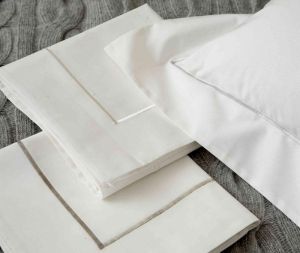Pillow cASES
Transform your bedroom with our beautiful collection of pillow cases that combine style, comfort, and quality to make every night feel like a luxury hotel experience. Whether you need standard size pillow cases or king size pillows for larger beds, our range features elegant satin stitch details, classic oxford borders, and clean plain designs that suit any bedroom décor.
While you have options like to shop at Sheet Street or buy Continental pillow cases our pillowcases are crafted to precise standard sizes in centimeters, guaranteeing a flawless fit every time. With premium thread counts ranging from 200tc to 400tc and more, each pillowcase promises a gentle touch against your skin and exceptional longevity. Also offering the choice of style like an Oxford border with satin stitching for a classic look, or opt for a sleek plain design.
Whether you choose a single standard pillow case to refresh your current bedding or invest in a complete set of king pillowcase, the right pillowcase makes your bed look professionally styled while ensuring you wake up feeling refreshed – because great sleep starts with the perfect pillow case that combines comfort, durability, and beauty in one simple upgrade.
satin pillowcases

style OPTIONS
You can choose between plain, oxford, oxford with one row satin stitch or oxford with two row satin stitch.
We highly recommend our 100% cotton percale fabric or the satin. We also have the options of 50/50 or 80/20 poly cotton. Colors are white, light grey, charcoal, sand and duck egg.
Material
Thread counts
Thread counts are the following: 200tc to 800tc
Sizes that we offer are the following. Standard (45x70) King (50x90)
Sizes
satin pillowcases

style OPTIONS
You can choose between plain, oxford, oxford with one row satin stitch or oxford with two row satin stitch.
We highly recommend our 100% cotton percale fabric or the satin. We also have the options of 50/50 or 80/20 poly cotton. Colors are white, light grey, charcoal, sand and duck egg.
Material
Thread counts
Thread counts are the following: 200tc to 800tc
Sizes that we offer are the following. Standard (45x70) King (50x90)
Sizes
get your quote today
Get in touch for your formal quote!
Frequently asked questions
What is the point of a pillow protector?
A pillow protector serves as a barrier between your pillow and pillowcase, extending your pillow's lifespan significantly. It protects against sweat, oils, dead skin cells, dust mites, allergens, and spills that can penetrate through pillowcases. This protective layer keeps your pillow fresher and more hygienic, while also maintaining its shape and support over time. For people with allergies or asthma, pillow protectors create an additional defense against dust mites and other allergens that can accumulate in pillows.
What type of pillow protector is the best?
The best pillow protector depends on your specific needs, but zippered encasement protectors offer the most comprehensive protection. Look for protectors made from tightly woven fabrics with a pore size smaller than 6 microns to effectively block dust mites. Cotton terry cloth protectors provide good breathability and comfort, while waterproof options with breathable membranes (like polyurethane backing) offer liquid protection without sacrificing airflow. For allergy sufferers, hypoallergenic materials like bamboo or specially treated cotton work well. Avoid vinyl protectors as they can be noisy and trap heat.
How often do you wash a pillow protector?
Pillow protectors should be washed every 2-4 weeks, or at least once a month. If you sweat heavily at night, have allergies, or are recovering from illness, wash them more frequently—potentially weekly. Always wash pillow protectors in hot water (at least 130°F) to kill dust mites and bacteria. Use a gentle, fragrance-free detergent and avoid fabric softeners, which can reduce the protector's effectiveness and breathability. If you are a loding business then after every guest has checked out you must wash the protectors.
Should the pillow protector be bigger than the pillow?
A pillow protector should fit snugly around your pillow without being too tight or too loose. It should be the same size as your pillow—not bigger. An oversized protector will bunch up and create uncomfortable lumps, while one that's too small won't provide complete coverage and may be difficult to put on. Most protectors are designed with slight stretch or are cut to accommodate the pillow's loft, so choose the protector that matches your pillow's dimensions (standard, queen, or king).
Why do pillow protectors turn yellow?
Pillow protectors turn yellow due to a combination of factors, primarily the natural oils from your skin and hair, sweat, and oxidation over time. Body oils and perspiration contain proteins and minerals that can cause fabric discoloration, especially when exposed to heat and time. Poor washing habits, such as using water that's too cool or not washing frequently enough, can allow these substances to build up and set into the fabric. Using bleach or harsh chemicals can also cause yellowing through chemical reactions with the fabric fibers. To prevent yellowing, wash regularly in hot water, use enzyme-based detergents, and ensure thorough rinsing.